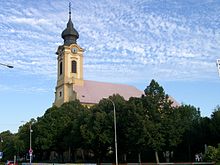User:Rokarudi/Workshop/Sered'
{{Geobox|Settlement}}
Sereď ( Hungarian: Szered ) is a town in southern Slovakia near Trnava, on the right bank of the Váh River on the Danubian Lowland. It has 17,406 inhabitants and is the largest settlement of the Galanta District.
It has a hotel, cinema, culture house, many restaurants and confectioner's shops.
Geography
[edit]
Sereď lies at an altitude of 129 metres (423 ft) above sea level and covers an area of 30.454 square kilometres (11.8 sq mi).[1]
It is located in the Danubian Lowland on the Váh river, around 20 kilometres (12 mi) south-east of Trnava, 33 kilometres (21 mi) west of Nitra and around 55 kilometres (34 mi) east from Bratislava.
The closest mountain ranges are the Little Carpathians to the west and Považský Inovec to the north.
History
[edit]


The town was first mentioned in 1313 as Zereth. In the Middle Ages, it lay on the trade route called "Bohemian Road" which ran from Buda to Prague on the right bank of the Váh river. Thanks to its location, livestock and grain markets were held in the town and thousands of cattle moved through the town each year. Its commercial importance ended in 1846, when the Pozsony-Nagyszombat (now: Bratislava-Trnava) railway was built. However, the Seredian market tradition survived and the Seredian Market and Bier festival is held every year on St. John Baptist's Day (24th of June). Sered had also been a large raft port and an important waterway until 1943 when a dam was built on the river Vah at Nosice. Since rafts carried not only wood but also salt from Poland, a major salt warehouse was built and the salt authority operated here. Its good location also attracted industrial investment. In 1845, a sugar refinery, later coffee processing and baking plant was opened.
In 1910, it had a population of 5371, among them 2941 Slovaks, 1943 Hungarians and 429 Germans. Until 1918, it belonged to Galánta District of Pozsony County of the Kingdom of Hungary. After the Treaty of Trianon, the town became part of Czechoslovakia in 1920.
Sered was the site of the only labour camp for Jews established in the pro-Nazi, pro-Nationalist Slovak state during WW2. The Jewish Code adopted by Slovakia in 1941 established labour camps for Jews. During the winter of 1941-1942, a team of Jewish craftsmen was sent to a military camp near Sered to prepare the camp for Jewish labour draftees. Before the work was completed, the Slovak authorities had utilised the camp as a detention centre for Jews and as a staging ground for deportation to Poland. The Hlinka Guard, commanded by Imrich Vasina, oversaw the camp. In five transports, 4,500 Jews were deported from the Sered camp to Poland. In 1944, an underground movement was organized in the camp and weapons were smuggled in. Many Jews left the camp and joined the partisans when the camp was opened during the Slovak national uprising in August 1944. Shortly thereafter, however, the Germans regained control over western Slovakia, and the camp was enlarged under the command of Alois Brunner. Over the next several months during the winter of 1944 and spring of 1945, 13,500 Jews were deported from Sered to Auschwitz and Theresienstadt. The camp was liberated by the Red Army on April 1, 1945.
In 1950, the sparkling wine manufacturer, Hubert company moved to the town. Sered was also a centre of nickle production during the socialist era, but after its fall, the foundry was closed down in order to protect Sered as a traditional agricultural region.
Cityscape and architecture
[edit]
The historically most important building is the Esterházy manor-house (castle) which stays on the place of the once famous medieval water-castle of Sempte. The manor-house was built in 1840 in classicist style, it was later altered in empire style. It is now in ruins and waits to be restored. The remains of the medieval castle is hidden in its walls. The local authority and civil association Vodny Hrad do their best to save this symbol of the town.

The John The Baptist´s church is situated on the opposite place of former parish church since 1781. When the former church burned down on August 2nd, 1777, the family Esterhazy decided to built new one and they moved there the two renaissance tomb-stones with relief of anti-Turkish warriors.
The Holy Trinity-column can be seen left from the church. It was erected in the second half of the 18th century in baroque style with tzhe scupltures of Saint Peter, Saint Paul and Saint Anne.
The old City Hall was built in 1909 by architect János Tomascheck, nativ of Sered. There is a great council chamber in the building, which is now used as marriage room. It is decorated with valuable paintings depicting views of St. Petersburg brought by Nikolaus Esterházy from his diplomatic mission in 1771.
Demographics
[edit]According to the 2001 census, the town had 17,406 inhabitants. 96.16% of inhabitants were Slovaks, 1.32% Hungarians, 0.95% Czechs and 0.65% Roma. The religious makeup was 72.52% Roman Catholics, 20.77% people with no religious affiliation and 1.97% Lutherans.[1] The religious makeup was 72.52% Roman Catholics, 20.77% people with no religious affiliation and 1.97% Lutherans.[1]
Economy
[edit]
- Slovenské Cukrovary
- Hubert J.E.
- Semmelrock
- SEDITA
- B.M. Kávoviny
- ZIPP
- FM Logistic
People
[edit]
- Max Weiss, chess player
- Filip Müller, Holocaust survivor and memoirist
- František Kubač
- Jaroslav Červenka
- Juraj Fándly
- Vojtech Mihálik
- Ján Sokol
- Ján Navrátil
- Alexander Noskovič
Twin towns — Sister cities
[edit]Sereď is twinned with:
 Tišňov, Czech Republic
Tišňov, Czech Republic Leopoldsdorf, Austria
Leopoldsdorf, Austria Alblasserdam, Holland
Alblasserdam, Holland
References
[edit]- ^ a b c "Municipal Statistics". Statistical Office of the Slovak republic. Retrieved 2008-01-28.
